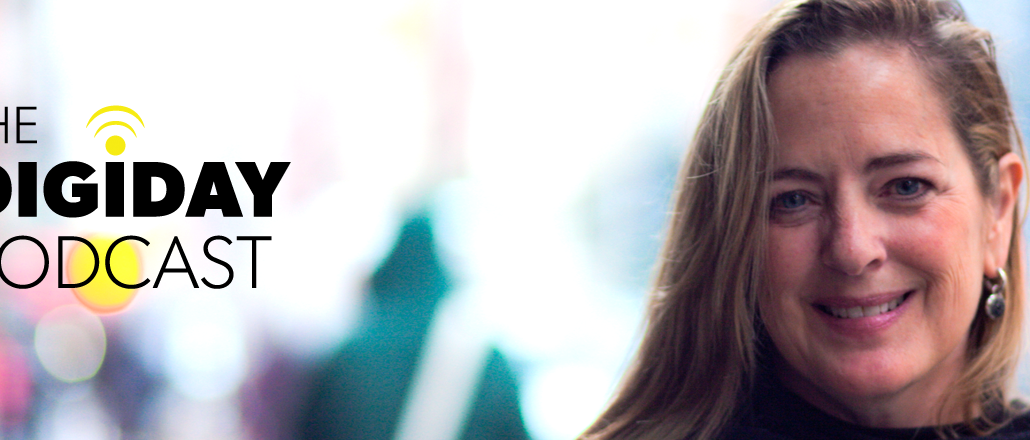
Much has been said about the death of the big agency and the dumbing down of creative in a digital-first world. But Susan Credle, the incoming global chief creative at FCB, thinks the real problem is the deterioration of ad quality.
Credle, who joined the Digiday Podcast this week, said to go back to the days of great advertising, agencies need to look hard at the immense amount of “offensive” garbage that they’re putting out in the world.
“Just look at banner ads,” she said. “We don’t even know how to break type on banner ads. It’s disgusting and offensive. There are words at the bottom of the left-hand corner for no reason. Advertising online needs to be like architecture. Sure, you can build a box that keeps you warm and provides shelter. But it drags down society because it’s ugly.”
Some edited highlights from the podcast:
The big agency isn’t a dinosaur.
Credle, who has spent most of her career inside large shops like BBDO and Leo Burnett, has spoken about the pros of legacy shops, one of the big reasons she also joined FCB. Small agencies often will argue that they’re nimbler. Credle says it’s a pointless debate. “Discussing the size of an agency is a lot like discussing what’s the best water to be in: ocean, lake, river, stream, tub. Depending on what you need, they’re all acceptable,” she said. “What I love about big agencies is big agencies can do big things. Big agencies are full of micro-agencies within it. They’re very nimble, but when you get in trouble, you can call on the entire company to help.”
But the big agency does have some issues.
While the creation of content isn’t usually a problem just because of an agency’s shop, Credle said big companies are often held back just by the “legacy of time.” For example, contracts that were created back in the day for a client that stipulated certain demands are often hard to change. “Big agencies have a harder time being nimble in as far as policy.”
Ad position: web_incontent_pos1
Digital advertising has created more stress at agencies.
Credle said the extra work required to make 15 YouTube clips instead of one TV spot has contributed to the stress. But she sees another harmful consequence. The amount of content that brands (and their shops) are putting out on the Web is scary and, usually bad, overwhelming consumers and taking time from the brand-building they should be doing, she said.
“We’re creating a lot of stuff and at some point, we have to ask how much can someone consume?” she said. “Brands are out there spending a lot of money, hoping it’ll stick. I see us as the most wasteful industry. We put advertising out there. It disappears, it’s junk, it’s a mess, and it’s embarrassing.”
Agencies need to be responsible to the public first.
Credle said that the “always-on” mentality has driven consumers away from advertising, which puts everyone in trouble. Agencies need to be responsible to the consumer before the brand. “Put something in this world that matters,” she said. “Whether it’s educational, interesting or beautifully designed. But be responsible to being in public.”
The rise of in-house creative directors by brands could threaten the agency model.
On Thursday, Grey’s creative chief Tor Myhren left to join Apple as a marketing vp. That’s just the latest in a string of big-name creative agency hires by marketers. Credle said that that trend could threaten agencies by cutting them out of the picture entirely. But it’s not sustainable. “That requires incredibly talented people and the question is, are there that many incredibly talented people?”
Ad-blockers are undemocratic.
Credle doesn’t use an ad blocker because she needs to have a perspective on ads, but she worries that people are being served too many ads in proportion to the amount of editorial content they’re reading.
Ad position: web_incontent_pos2
Telling people to block ads or getting them to pay to avoid ads is a disservice, she said, and publishers and ad blockers shouldn’t do that. Overall, the advertising industry supports the creation of good content, including good journalism.
“If paid content is premium and everything else served is not so good, then we’re going to have a really bad time,” she said.
More in Marketing

In the marketing world, anime is following in the footsteps of gaming
As marketers look to take advantage of anime’s entry into the zeitgeist, they might be wise to observe the parallels between the evolution of anime as a marketing channel and the ways brands have learned to better leverage gaming in recent years.

With the introduction of video ads and e-commerce, Roblox looks to attain platform status
Roblox is expanding into more areas than just ads in 2024. Much like platforms such as Amazon and Facebook have transcended their origins to evolve from their origins as online marketplaces and social media channels, Roblox is in the midst of a transformation into a platform for all elements of users’ virtual lives.

PepsiCo wants to remain a ‘driver of culture’ as it turns to influencers and activations amid rebrand
The soda-maker says it can translate cultural relevance into sales volume.
Ad position: web_bfu